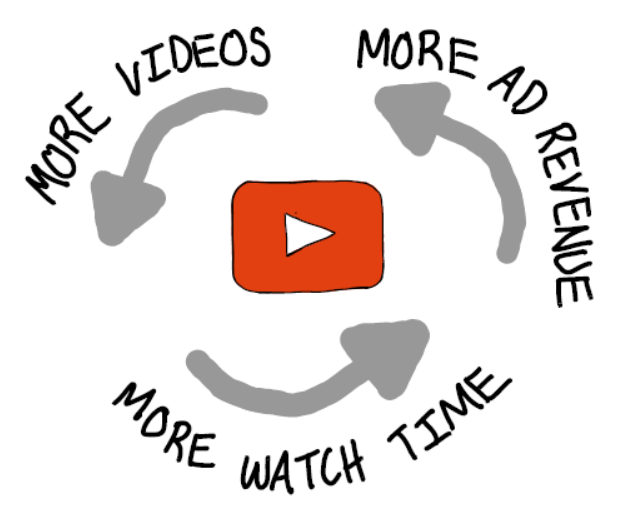YouTube's Success Cycle
February 4, 2022
The world has come to know YouTube as the source of videos. In 2011, generating $28.8 billion in ad revenue,
YouTube claimed their spot as the king of online video-sharing platforms. Since Google acquired YouTube in
2006, the platform continued to grow with new users coming to the platform daily. How did Google build such
a successful platform and how did they manage to continue the success until today? We’ll explore all of
these and why I use the platform daily in this post.
The goal of YouTube is to have a platform where anyone can upload videos and for anyone on the internet to
be able to watch said videos. From the abundant amount of advertisements on every video, YouTube is able to
give some of the ad revenue to the creators of these videos. This drives and acts as an incentive for the
creators to upload more videos, allowing the consumer to have more videos to watch, and hence more
advertisements that YouTube makes profit from. It’s an ingenious cycle that continues to grow the company
exponentially; I like to call it YouTube’s success cycle. Although YouTube’s success cycle seems perfect,
the company had to ensure they had enough creators to start this cycle. When YouTube first launched as a
video streaming platform, it was receiving 8 million views daily. With increasing creators on the platform,
the problem YouTube faced was growth. The platform would frequently run out of storage and lots of money had
to be spent on litigation as many videos being posted contained copyright materials. Hence, the platform
could not grow as fast as the company wanted it to. They then offered it for sale, and Google bought them
out in 2006 for $1.65 billion. With lots of money at Google's disposal, they were able to have enough
storage space, pay the litigation expenses, expand the application to many other countries, and launch a
mobile app extremely quickly. This rapid growth caused many media companies to start reporting on YouTube,
resulting in more users being exposed to the platform and start creating videos. This started the ever
growing cycle that can be seen in Figure 1.

Figure 1: Youtube's Success Cycle
From there, YouTube continued to roll out features that increased the amount of creators on the platform, as
well as increased the amount of time users spent on it. For instance, the Youtube homepage has an algorithm
to display content tailored towards the user. Personally, I find myself finishing one video, about to close
the platform, then returning to the homepage to find yet another appealing video that I want to watch. This
causes me to spend countless hours watching content and generating more ad revenue for YouTube. This can
also be seen as the total watchtime daily among all users on YouTube is 1 billion hours, thus it is safe to
assume I am not the only one who falls victim to YouTube’s appealing algorithm.
Although YouTube’s growth does not seem to be slowing down, there are some improvements to the platform that
will make more people create and watch videos. The first idea that came to my mind revolved around the
subscriptions tab on YouTube. The subscriptions tab currently displays the videos of YouTube content
creators (i.e. YouTubers) that you are subscribed to in chronological order. For instance, on my account, I
am subscribed to over 100+ YouTubers. This makes my subscriptions tab packed with random content. It’s
extremely overwhelming and deters me from using the subscriptions tab and subscribing to more YouTubers.
Instead, this tab should have the option to group YouTubers you are subscribed to. For example, I am
currently subscribed to many finance YouTubers, daily life vloggers, and gaming channels. These categories
are extremely different and it would be useful if they were separated so that I can scroll through the
specific category that I wanted to watch. This will likely increase watch time across users and also promote
subscribing to various YouTube channels. With more users subscribing to channels, it will motivate creators
to post more videos so they can receive even more subscribers, and once again, accelerate YouTube’s success
cycle. Another improvement that can be made would be adding smaller creators on the suggested category or
the homepage of YouTube. I have heard from many friends who have started a YouTube channel that they hardly
got any engagement on their very first few videos and hence they stopped uploading. This low engagement when
starting up a channel discourages new creators from coming to the platform. By giving exposure to smaller
creators, it will motivate the creator to keep on uploading videos and will make YouTube have even more
videos on the platform.
Adding these suggested improvements and continuing their ad revenue success cycle, YouTube has a
high potential to become the largest application in the world. Now, let me go make a YouTube video about my
YouTube blog!



